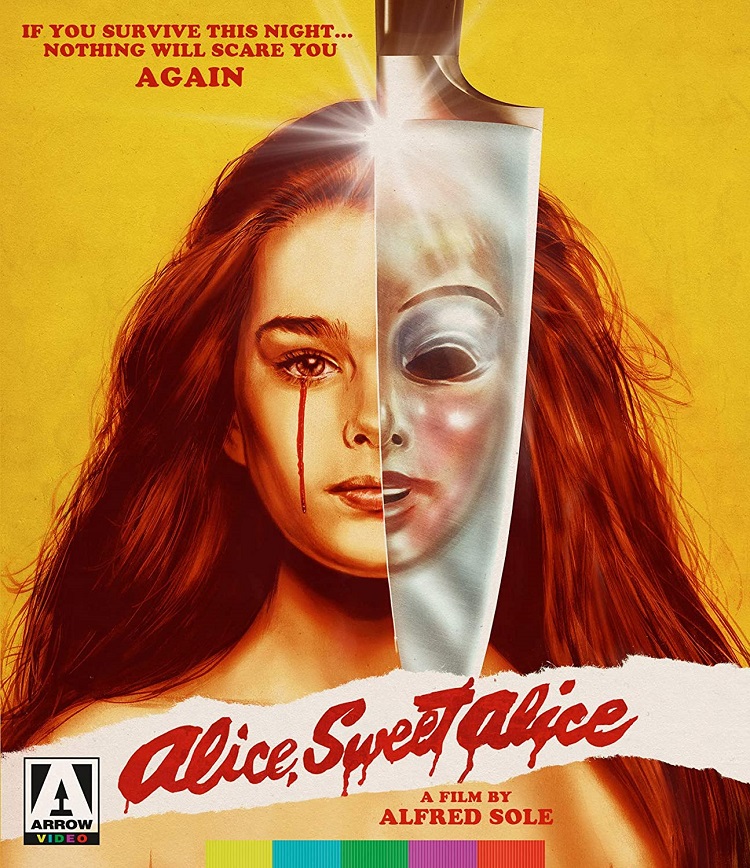
When it comes to horror cinema, I think 1970s horror stands at the top for me. Everyone, even those who don’t particularly care for the genre, has to have at least five or six favorites from that decade. There was something for everyone, meaning that every film, even the not-so-good ones had at least some type of theme to them. The ’70s was a decade of hopelessness and uncertainty, and its horror flicks reflected that. Even more so, there were a lot of often overlooked gems that flew under the radar, including Black Christmas (1974), The Crazies (1973), Martin (1977). However, Alfred Sole’s 1976 seminal religious slasher, Alice, Sweet Alice, is the arguably the one to see. It’s film that doesn’t fit a certain category of genre. In fact, it’s a film of many different moods that’s a lot more complex than meets the eye.
The disturbing tone of the film is set strongly by the brutal murder of young Karen Spages (Brooke Shields), where she is viciously strangled and set on fire by a masked figure before her first Communion. The initial prime suspect is Alice (Paula Sheppard), her older sister, who is withdrawn and emotionally unstable. This is apparent due to Alice’s jealousy towards Karen, because of her beauty and their mother Catherine’s (Linda Miller) and their priest Father Tom’s (Rudolph Willrich) attention to her, which set Alice astray. When her unhinged aunt Annie (Jane Lowry) is attacked, she immediately blames Alice, for which she is sent away.
Meanwhile, her estranged father Dominick (Niles McMaster) receives a call from Annie’s daughter saying that she has Karen’s crucifix and that she wants to give it to him. This leads to a truly horrifying sequence where he is attacked and eventually killed by the figure, where his teeth are bashed in and he is pushed out of an abandoned building. This is where the film takes a drastic turn, because the killer is revealed, but it is not Alice. It is Mrs. Tredoni, Tom’s overly devout housekeeper, who not only looks as if she is trying to pin the crimes on Alice, but is obviously angry that Catherine and Dominick had children before marriage. In the end, there is a tense sequence during Mass as the police close in on her, where she is discovered after suddenly killing Tom. The culprit may have been found, but what are we really left with?
For film made on a limited budget, it is expertly filmed. It’s predates John Carpenter’s Halloween (1978) by two years, and is clearly inspired by not only Nic Roeg’s Don’t Look Now (1973), but the then-popular Italian giallo boom with the likes of Argento and Bava. The music is spooky and strange, the location feels different and eerie, and the performances range from subtle to almost high camp. Even when the killer is revealed, Sole still smartly keeps the characters and the audience in the dark until the very end.
Although Alice, originally titled Communion and Holy Terror, was in later years built on the star power of Shields, the real star is Sheppard, whose passiveness and mysterious performance elevates the film, especially with the haunting final shot where she looks directly into the camera, which subtly suggests the making of a sociopath. Shields’s murder at the beginning of the film is still quite shocking today, and I’m surprised that Sole was allowed to get away with it. He packs on the atmosphere, which feels dangerous as characters who you don’t expect to die are suddenly done in.
This is the essence of horror because the viewer doesn’t feel safe and you don’t know where its going. There is also the matter of all the religious iconography etched into the entire film, which was one of the reasons for the mixed reviews it received when first released. Some people acclaimed it for the creepy success that it truly is, while others deemed it as a slap in the face to Catholicism and the church. Whatever you want to call it, the film remains a sinister classic of 1970s American horror.
As usual, the folks at Arrow have done an amazing job at rescuing it from almost obscurity, with a new 2K restoration, and many of these great special features:
- Brand new audio commentary with Richard Harland Smith
- Archival commentary with Sole and editor M. Edward Salier
- First Communion: Alfred Sole Remembers Alice, Sweet Alice – director Sole reflects on his classic film
- Alice on My Mind – a brand new interview with composer Stephen Lawrence
- In the Name of the Father – brand new interview with actor McMaster
- Sweet Memories: Dante Tomaselli on Alice, Sweet Alice – filmmaker Dante Tomaselli, cousin of Sole, discusses his longtime connecton to the film
- Lost Childhood: The Locations of Alice, Sweet Alice – a tour of the original shooting locations hosted by author Michael Gingold
- Alternate Holy Terror Television Cut – with alternate title and different editing choices
- Deleted Scenes
- Alternate Opening Titles – Alice, Sweet Alice (in later reissues)
- Original trailer and UK TV Spot
- Image Gallery
- Original Screenplay (BD-ROM content)
Rounding out the release is a reversible cover with the original poster, a collectible poster featuring the new cover art, and a new essay by BFI film programmer Michael Blyth.
I just have to say that although I’ve seen this film several times before, I’m still struck by the boldness of the direction Sole takes with the subject matter and twists. It has surprisingly aged very well, and it retains its sublime creepiness all the way through, especially for a film that is 43 years old.